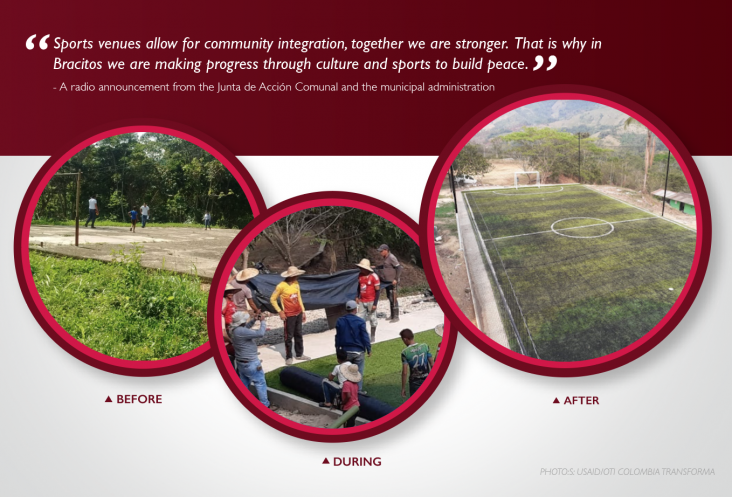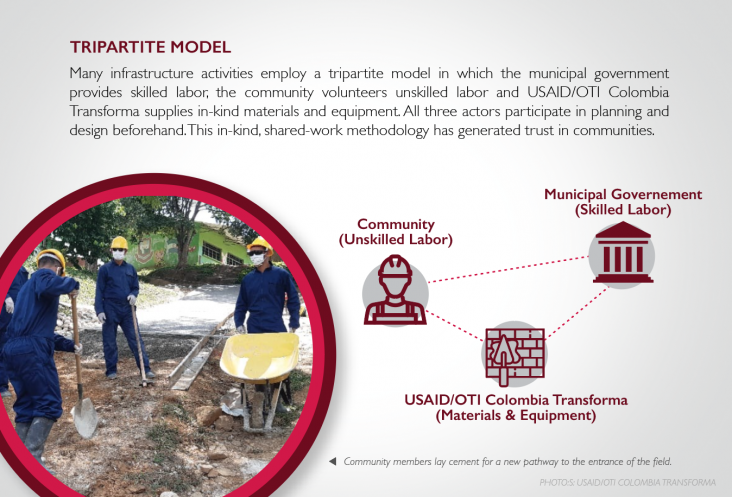Speeches Shim

Bracitos is a small village of 300 inhabitants located just 20 minutes from the municipal seat of El Tarra, a place emblematic of the conflict in the Catatumbo region for events like the paramilitary raids in 2003 and the displacement of dozens of families in 2012. As the starting point for the Road Ring for Peace, a highway critical to peace and economic inclusion of the Catatumbo region, the town has become an important crossroads for the mobility of goods and services. Thanks to the contribution of unskilled labor from the community, the purchase and installation of grass by the Mayor, and materials supplied by Colombia Transforma, it only took 5 months to establish the first synthetic soccer field in the entire municipality of El Tarra.
This is one of the first visible actions of Peace Accord implementation in the village, prioritized by the community during the development of Development Programs with a Territorial Focus (PDETs), and demonstrates the value of co-responsibility to legitimize the Peace Agreement across the region.

STRENGTHENING THE JUNTA DE ACCIÓN COMUNAL
By organizing the community contribution and publicizing it on a billboard for the entire village to see, the Junta de Acción Communal (Community Action Board or JAC) felt a sense of ownership over the project from the beginning. “This is good for the whole community, we all wanted to work. The groups had their own representative that organized everyone each day and informed them of their daily tasks.” This level of coordination was particularly visible in February 2020, when despite an armed strike by the EPL and ELN guerilla groups, the community continued working without delay.
It was the JAC that motivated the community to work together with the El Tarra Mayor’s office. “Initially, it was difficult to do this in rural areas, but we always knew it was possible. We talked with the community, and we talked about how this would come with difficulties that we had to overcome. We set up the project together by planning and speaking with the mayor; we also co-financed and knew we were going to do what had to be done.” The community’s commitment to working together was strong enough that, with their own resources, they were also able to build a large pavilion next to the field.
The process generated important lessons learned for the JAC, which had not previously signed a similar agreement with the community until now. At the beginning, there was apprehension around whether the JAC could fulfill their commitments in a timely manner. "What if we fail to deliver the work at the agreed times?" This however, was not the case. The JAC rose to the challenge by accurately estimating timelines, organizing the community, and coordinating with the municipal administration.
THE JAC AND MAYOR’S OFFICE WORK TOGETHER
A change in local government generated doubts about the project agreement with the municipal administration. This sentiment was alleviated after initial conversations between the JAC and the Mayor’s office, which were facilitated by Colombia Transforma. Despite being short-staffed and at the start of their first term, the Mayor’s office was ready to listen to the JAC and contribute resources to the project, recognizing the impact it would have on their long-term relationship with the community.
ADVANCING THE IMPLEMENTATION OF THE PEACE AGREEMENT FROM THE BOTTOM-UP
“Sports venues allow for community integration, together we are stronger. That is why in Bracitos we are making progress through culture and sports to build peace.” (A radio announcement from the Junta de Acción Comunal and the Municipal Administration)
Improved infrastructure is a tangible and visible form of evidence of how the Peace Agreement is being implemented in the region, as long as it is explicitly communicated and executed in places highly affected by armed conflict. In the neighboring communities of Bracitos, community members contemplated why this kind of work was being done in a rural area when it is typically carried out in an urban setting.
For both the JAC and the community of the Bracitos district, the possibility of recreation, sports, and cultural events in their own venue is something new, which assures them that territorial transformation is at the core of the Peace Agreement, and is well underway. "Today, we are at the same level as any urban area. We have a good recreational setting that allows us to meet, organize, build peace, and open other spaces to solve problems…through culture, sports and recreation we build peace and a number of things that are essential for coexistence and the development of a human being.” (JAC)
Many infrastructure activities employ a tripartite model in which the municipal government provides skilled labor, community volunteers provide unskilled labor and USAID/OTI Colombia Transforma supplies in-kind materials and equipment. All three actors participate in planning and design beforehand. This in-kind, shared-work methodology has generated trust in communities.


Comment
Make a general inquiry or suggest an improvement.